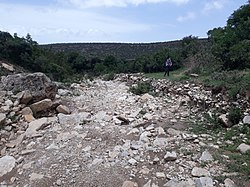
Mika’el Abiy is a tabia or municipality in the Dogu’a Tembien district of the Tigray Region of Ethiopia. The tabia centre is in Megesta village, located approximately 7 km to the southeast of the woreda town Hagere Selam.

Degol Woyane is a tabia or municipality in the Dogu'a Tembien district of the Tigray Region of Ethiopia. It includes Dabba Selama, the oldest monastery of Ethiopia, and the most inaccessible in the world. The tabia centre is in Zala village, located approximately 10 km to the west of the woreda town Hagere Selam.
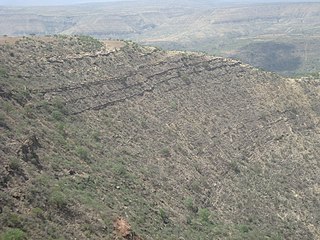
Amanit is a tabia or municipality in the Dogu'a Tembien district of the Tigray Region of Ethiopia. The tabia centre is Addi Qeshofo village, located approximately 15 km to the southeast of the woreda town Hagere Selam.
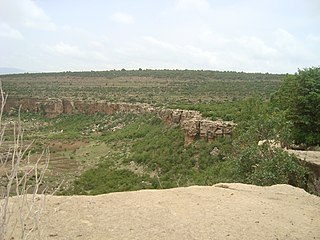
Debre Nazret is a tabia or municipality in the Inderta district of the Tigray Region of Ethiopia. It belonged to Dogu'a Tembien up to January 2020. The tabia centre is in Togogwa town, located approximately 19 km to the east-southeast of Hagere Selam and 25 km to the west of Mekelle.
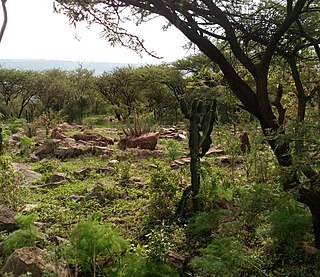
Addi Azmera is a tabia or municipality in the Dogu'a Tembien district of the Tigray Region of Ethiopia. The name refers to good spring rains (“azmera”), in relation to the local microclimate. The tabia centre is in Tukhul town, located approximately half-way between the woreda town Hagere Selam and the regional capital Mekelle.

Emni Ankelalu is a tabia or municipality in the Dogu'a Tembien district of the Tigray Region of Ethiopia. The tabia centre is in Mitslal Afras village, located approximately 20 km to the east of the woreda town Hagere Selam.
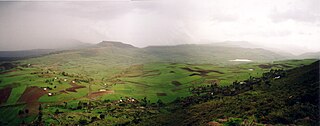
Arebay is a tabia or municipality in the Dogu'a Tembien district of the Tigray Region of Ethiopia organised around the Arebay mountain peaks. The tabia centre is in Arebay village, located approximately 13 km to the east-northeast of the woreda town Hagere Selam.

Addi Walka is a tabia or municipality in the Dogu'a Tembien district of the Tigray Region of Ethiopia. The tabia centre is in Kelkele village, located approximately 16 km northeast of the woreda town Hagere Selam.

Haddinnet, also transliterated as Hadnet, is a tabia or municipality in the Dogu'a Tembien district of the Tigray Region of Ethiopia. The tabia centre is in Addi Idaga village, located approximately 6.5 km to the northeast of the woreda town Hagere Selam.

Mahbere Sillasie is a tabia or municipality in the Dogu'a Tembien district of the Tigray Region of Ethiopia. The tabia centre is in Guderbo village, located approximately 2.5 km to the west-northwest of the woreda town Hagere Selam.
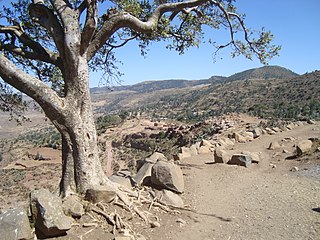
Aregen is a tabia or municipality in the Dogu'a Tembien district of the Tigray Region of Ethiopia. The tabia centre is in Addi Gotet village, located approximately 11 km (6.8 mi) to the west-southwest of the woreda town Hagere Selam.

Menachek is a tabia or municipality in the Tanqua Millash district of the Tigray Region of Ethiopia. The tabia centre is in Addi Bayro village. Until January 2020 it belonged to the Dogu'a Tembien district.

Inda Sillasie is a tabia or municipality in the Dogu'a Tembien district of the Tigray Region of Ethiopia. The tabia centre is in Migichi village, located approximately 13 km to the south-southeast of the woreda town Hagere Selam.

Simret is a municipality in the Tanqua Millash district of the Tigray Region, Ethiopia, which comprises the longest cave of Tigray in Zeyi, as well as Ras Alula’s birthplace in Mennewe. The municipality centre is in Dengolo village. Until January 2020, Simret belonged to the Dogu'a Tembien district.

Walta is a municipality in the Dogu'a Tembien district of the Tigray Region of Ethiopia. The tabia centre is in Da’erere village, located approximately 7 km to the south of the woreda town Hagere Selam.

Mizane Birhan is a tabia or municipality in the Dogu'a Tembien district of the Tigray Region of Ethiopia. The tabia centre is in Ma’idi village, located approximately 13 km to the southeast of the woreda town Hagere Selam.

Selam is a tabia or municipality in the Dogu'a Tembien district of the Tigray Region of Ethiopia. The tabia centre is in Addi Werho village, located approximately 3 km to the northeast of the woreda town Hagere Selam.
Seret is a tabia or municipality in the Dogu'a Tembien district of the Tigray Region of Ethiopia. The tabia centre is in Inda Maryam Qorar village, located approximately 11 km to the southwest of the woreda town Hagere Selam.

Lim’at is a tabia in the Dogu'a Tembien district of the Tigray Region of Ethiopia. The tabia centre is in Maygwa village, located approximately 8 km to the southwest of the woreda town Hagere Selam.
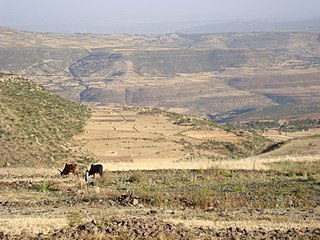
Ayninbirkekin is a tabia or municipality in the Dogu'a Tembien district of the Tigray Region of Ethiopia. Literal meaning of Ayninbirkekin in Tigrinya is "We will not bend". The tabia centre is in Halah village, located approximately 8 km to the east of the woreda town Hagere Selam. Main town is Ala'isa, situated on the ridge overseeing the Giba valley.
